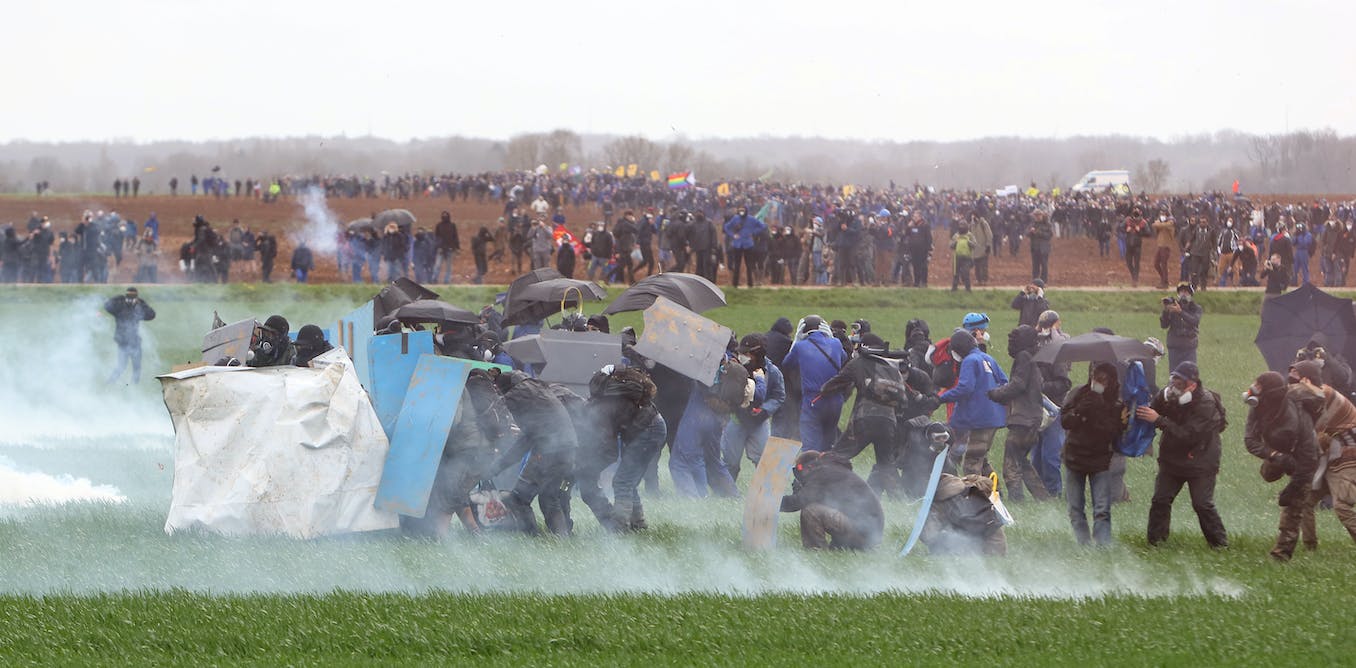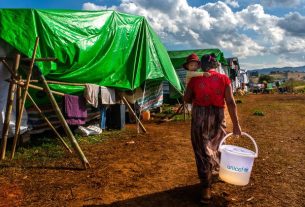The idea of adjusting our lives to face up to the reality of a changing climate was, for a long time, seen as defeatist, or even a capitulation to fossil-fuel interests, by many within the European climate movement. Such “adaptation” was viewed with deep scepticism.
But 2023 challenged such assumptions. In autumn, activists ramped up protests against ski resorts and the winter-sports industry for their seemingly endless appetite for winter sports infrastructure. Environmentalists occupied the Girose Glacier in southeastern France to denounce plans for a new cable car. Deep scepticism was also expressed over whether holding preseason sporting events following the partial destruction of the Théodule Glacier in Switzerland.
By taking a stand, these ecologists were pressing authorities to rethink planning beyond the skiing model and its dependency on “white gold”. Far from constituting adaptation, they argued that the construction of winter sports infrastructure in the remaining snow-capped mountains threatened fragile ecosystems and only postponed the inevitable shift to alternative economic models. For them and others, it constitutes “maladaptation” – actions exacerbating communities’ vulnerability to climate variability.
Even more spectacular were protests against proposed water reservoirs in Sainte-Soline, western France, in March. Up to 30,000 protesters showed their opposition to the project, arguing that the dams, intended to collect fresh water during wet seasons to provide for increasingly drier periods, were inefficient due to water evaporation, and ultimately prioritised the interests of large agribusiness over locals’ rights.
The question of adaptation was therefore thrust into the spotlight like rarely before. Such protests demonstrate how deeply political climate adaptation is. What one group may perceive as positive adaptation may look like maladaptation to another, and a political struggle determines which view prevails. The environmental philosopher Andreas Malm described Sainte-Soline as an “avant-gardist struggle”.
From idea to real life?
For many years, academics have sought to shed light on competing interests that are often hidden in technocratic processes inherent to adaptation. For example, dikes intended to guard against flooding may appear as a reasonable solution to some, but others could consider them a maladaptation due to their tendency to increase flooding downstream. To overcome such tensions, academics have attempted to imagine a model that would not merely serve the interests of the wealthy and powerful or the economic status quo. This has become known as transformational adaptation.
In 2021, the Intergovernmental Panel on Climate Change (IPCC) defined transformational adaptation as:
“actions aiming at adapting to climate change resulting in significant changes in structure or function that go beyond adjusting existing practices”
“deep and long-term societal changes that influence sustainable development (include values, worldviews)”
Transformational adaptation thus requires that vulnerable communities be able to take part in designing adaptation policies, and that systemic drivers of vulnerability like poverty or discrimination be addressed. Yet while some have found partial examples of how this might happen, such as in the city of Barcelona, discussions of transformational adaptation have remained largely conceptual.
Swedish activists overlooked adaptation
Andreas Malm’s description of Sainte-Soline as an “avant-gardist struggle” makes particular sense when we compare it to other European climate initiatives in recent years. Focusing on climate movements’ activities between 2018 and 2020, my research shows that European climate movements have seldomly taken up this role, raising the question of why this might be the case and what it might take for them to do so.
In a study of climate adaptation in the Swedish city of Malmö, Salvatore De Rosa (Lund University), Marwa Dabaieh (University of Malmö) and I found that vulnerable communities were regularly exposed to issues of flooding and urban heat and lacked the resources to adapt. At the same time, they lacked the political capital to confront city authorities, leaving them to resort to ad hoc methods such as sleeping in one’s garden or spending the day in air-conditioned malls. Meanwhile, city officials believed there was little need or demand to open adaptation planning to citizen input. Given this mismatch, we explored what role local climate movements, who enjoyed considerable political clout at the time of our study (2018-2019), could play to put the issues faced by vulnerable communities on the agenda.
We found that while local climate activists were worried about adaptation, they mainly prepared for climate disruptions by taking action at an individual level – such as taking part in local food-growing initiatives or storing drinking water in one’s basement. They did not expand this concern to include members of the most vulnerable local communities. We found this to be the case for a number of reasons, including a lack of ties between the climate movement and vulnerable communities, a global understanding of climate justice that overlooked local issues, and a hesitation to engage with climate adaptation because doing so was considered to be a defeatist excuse for inaction.
Similar trends from Hamburg to Antwerp, Bristol to Manchester
In another 2022 study, I compared the attitudes and actions on climate adaptation of activists in Malmö to those in four other European cities (Hamburg, Antwerp, Bristol and Manchester), finding similar patterns overall. The persistent lack of engagement with adaptation was particularly striking because most activists to whom I spoke indicated they thought it was already too late to avoid severe climate disruptions and runaway climate change.
While some recent studies link such beliefs to a shift in focus from trying to mitigate climate change to adapting to it, I found that most activists remained focused on mitigation. For instance, they remained focused on demanding governments cut emissions in their protests, or developed green energy initiatives locally. I found their actions were not primarily guided by a logic of consequences (acting on the basis of expected utility) but by a logic of appropriateness (doing what is considered to be “right”, including not giving up on mitigation), of habit (campaigning toward the usual ends), and of affect (avoiding negative feelings by focusing on productive actions).
Short-term carbon cuts
In a 2023 paper co-authored with political scientist Jens Marquardt, we found that activists campaigning for a local energy transition in the UK managed their fears that it might already be too late for mitigation by acting in the here and now, rather than situating actions in a long-term climate change and decarbonisation trajectory.
While this “presentism” proved an effective way to not become paralysed by climate anxiety, we also observed that it created certain tensions and blind spots. In particular, activists told us they sometimes worried they were not being honest with themselves, and that they should perhaps focus more on action that anticipates and adapts to climate disruptions they no longer considered preventable. However, the question of what that adaptation strategy might look like generated such fear and uncertainty that they preferred to pursue mitigation actions they did not always consider realistic, even if that sometimes made them feel dishonest.
That being said, this didn’t make activists any less rational to our eyes. Given what is at stake and knowing that adapting to runaway climate change is impossible, mitigation undoubtedly makes sense. Our research recognises that focusing on the here and now can keep climate activists going under the direst of conditions. Nevertheless, it also reveals pitfalls. Specifically, it reveals why despite underlining the increasing importance of adaptation for climate justice, climate activists hardly ever played a role in politicising this topic – especially at a local level.
Opportunities to focus more on adaptation
Will the events of 2023 in France and Switzerland be regarded as exceptions, or do they usher in a broader trend toward transformative adaptation?
The ball is in the court of climate activists. Should they follow the lead of Sainte-Soline, senior figures in climate movements can at least rest assured that shifting the focus to adaptation will resonate with their rank and file. In another study I found that at least half of a representative sample of 2,152 participants from the 2019 Global Climate Strikes attributed equal importance to adaptation and mitigation. Venturing into adaptation politics may therefore speak directly to the concerns of many activists fighting climate breakdown.



